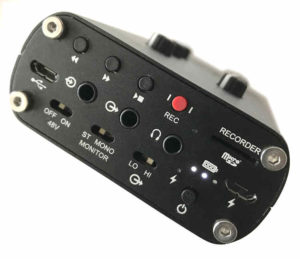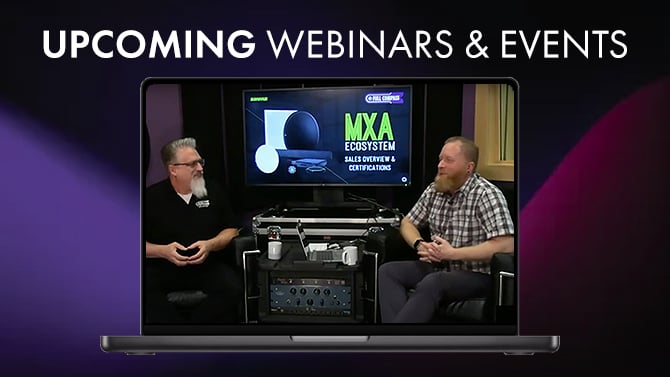Mobile recording’s popularity continues to grow. Podcasts were already on the upswing before COVID-19 hit, but because of the pandemic, streaming Definition:
Definition:
A method of sending a continuous flow of digital content over IP (Internet Protocol) networks, and often, tailors itself to the user's receiving capability. is becoming more common than ever. Although a lot of streaming involves mobile devices like smartphones and tablets, their audio quality has not kept up with their video quality. Despite the many interface/mixers designed for podcasting and streaming with mobile devices, the options for a premium-quality, self-contained device that’s optimized for mobile applications are limited.
Fortunately, CEntrance’s MixerFace R4R is clearly designed for sophisticated mobile applications. It’s a mixer Definition:
Definition:
Combiner, controller, and router for multiple audio or video signals., high-quality set of preamps, optional SD recorder, and USB Definition:
Definition:
(Universal Serial Bus) A standard, bi-directional serial connection between computers and peripheral devices. interface Definition:
Definition:
A device that adds I/O capability to another device. Common would be a MIDI, audio or video interface for a computer.. MixerFace supports iOS Definition:
Definition:
Apple proprietary operating system, primarily for mobile devices (iPhone, iPad, iPod Touch, Apple Watch). Current Apple TVs run on tvOS, which is similar to, and based on, iOS., Android, Mac, Linux, and Windows using USB 2.0 Definition:
Definition:
Stereo sound with 2 speakers and no subwoofer., but is electrically compatible Definition:
Definition:
Capable of operating with a particular selection of hardware or software. with USB 3.1 Definition:
Definition:
Also called SuperSpeed+. A higher-speed version of previous USP standards that retains backward compatibility. (USB-C Definition:
Definition:
A non-object-oriented, procedural, higher-level computer programming language than assembly language. connectors require a physical adapter).
R4 and R4R
The MixerFace R4 and R4R are virtually identical, except that the R4R has a built-in SD recorder. Both models accommodate AC Definition:
Definition:
(Alternating Current): Current whose electrical flow alternates between positive and negative quadrants, and whose magnitude varies periodically. Alternating current is used in most commercial power transmission, and is also the basis of audio or video signals. power via a USB adapter (not included), and a rechargeable battery Definition:
Definition:
An assembly of series-wired cells that provides higher voltages than individual cells. that lasts up to 8 hours (depending on how power-hungry your phantom-powered mics are). Note that you can charge/power with a USB charging port, while a second USB port handles audio. Nice.
Compared to my expectations, the MixerFace is both lighter (under 10 ounces) and more compact (4.75" x 1.5" x 2.75"—the ad copy says it’s the size of a passport, but it’s actually smaller). The build quality is clearly field-friendly—this is not something that can’t leave the house. It comes with a felt carry pouch, which protects it from scratches when being jostled around with other gear Definition:
Definition:
Musical or performance equipment. in a backpack. One of the more surprising aspects is how something that feels so substantial can also feel so portable.
Let’s start with the audio I/O Definition:
Definition:
(Input/Output): 1. A pair of connections that provide input(s) and output(s). 2. The connections that link a computer to devices outside the computer.. Each of the two Neutrik mic/line/instrument combo jack Definition:
Definition:
A connector, normally female, that works in conjunction wit a plug. Usually located in a piece of equipment, or as part of a cable. inputs (Fig. 1) have Hi-Z Definition:
Definition:
High impedance (Z stands for impedance). The input or output impedance is relatively high, although what is "relatively high" depends on the type of gear. High-impedance mic outputs range from 500-50,000 ohms, guitars pickups from 7,000 to 100,000 ohms (depending on frequency), and tube guitar amp inputs are typically 1,000,000 - 5,000,000 ohms. and high-pass filter Definition:
Definition:
A circuit or sometimes, mechanical device that passes audio above a specific frequency, and attenuates audio below that frequency. A typical audio application is reducing frequency response below 50-200 Hz to minimize hum, room noise, plosives, and bass reflection build-ups due to acoustical issues. switches, gain Definition:
Definition:
The amount of amplification provided by an amplifier circuit, expressed in dB or numerically as in "3X" = "3 times". controls with LEDs for peak Definition:
Definition:
A signal's maximum level at any point in time. and signal, and a switch that supplies phantom power Definition:
Definition:
A source of power for a microphone (usually condenser) that travels to the microphone over the microphone's cable. There are different voltage standards and requirements for different microphones, but the most common standard is 48 Volts. It derives its name because there is no visible power cable. to both mic inputs. The Hi-Z input is 1 Megohm...a welcome touch for guitar and bass players. A stereo Definition:
Definition:
A two channel signal simulating a sound space, typically played through two speakers. minijack handles the Aux 3 and 4 line inputs, and each channel Definition:
Definition:
1. In radio, television, citizen's band radio, and other wireless communications modes, a specific frequency for communication. 2. In mixers and video, an input or output signal path with controls. 3. In MIDI, one of 16 data paths. also has a monitor Definition:
Definition:
1. (audio) A loudspeaker or headphone/earphone used for accurate reference monitoring for recording or broadcast. 2. (live performance) A device that reproduces sound, like an in-ear monitor or speaker wedge, so performers can hear themselves. See: IEM. 3. (computers) A device that provides a graphic representation of operations occurring inside the computer. 4. (video) A device that enables seeing what is occurring with a video shoot, or program material from a broadcast or other video media source. blend control (i.e., zero-latency Definition:
Definition:
The amount of delay a signal, data, sound, video, or control signal acquires within a device, system, or long-distance connection. monitoring) for the input and USB signal coming back from your mobile device to the MixerFace.

Two TRS Definition:
Definition:
(Tip Ring Sleeve) Phone style connector. 3 conductor (Stereo) originally 1/4" diameter, also 1/8" and smaller and the TT style for patchbays. Used for headphones and patching. minijacks handle the output to powered monitors. There’s also a headphone/monitor output control, low/high line output-level switch, mono/stereo monitoring switch, and pre-monitor 1/8" Definition:
Definition:
3.5mm mini phone connector, which is sometimes referred to by the close non-metric 1/8 inch dimension. stereo line output Definition:
Definition:
In audio, an output with a nominal level of -10 to +4 dBm that can drive loads from 600-20K ohms.. Figure 2 shows the R4R’s controls that are opposite from the input jacks.

Note that all the switches are recessed, so you can’t hit them accidentally. Cool...apparently someone actually used this before releasing the prototype for production. The MixerFace comes with a tool (like the ones used to open micro SD card Definition:
Definition:
(slang) A circuit board that contains circuitry and plugs into an edge connector. trays in smartphones) to move the switches, although something like a paper clip end or toothpick will also work if you lose or forget the tool.
The knobs are small, but rubberized so they’re easy to adjust, and recessed so they poke just far enough above the case so you can adjust them. This bodes well for long-term reliability—if you hit the knobs, I think it would be impossible to damage or break the pot Definition:
Definition:
Short for Potentiometer. See: Potentiometer. shafts. The case is anodized aluminum, not plastic. The overall vibe is sturdy, professional, and can probably handle unfavorable environments better than I can.
The SD recorder’s transport Definition:
Definition:
1. A tape recorder mechanism that moves tape. 2. DAW control simulating a tape recorder's mechanical transport. buttons are rewind, play/pause (or record/stop in record mode), and fast forward. Overall, operation is straightforward—the two Quick Start guides (one for general controls, and one for the recorder) are pretty much all you need to get going, unless you’ve never seen a mixer or audio interface Definition:
Definition:
A device to convert audio signals into digital code suitable for use by a computer; typically communication occurs through a port such as USB, Thunderbolt, FireWire, etc. before.
IN USE
Given the price and the professional orientation, I expected that the preamps would be good, but they’re excellent performers, with a non-existent “sound.” Other than being a little shy on gain (listed specs are up to 53 dB Definition:
Definition:
1. A deciBel is a logarithmic ratio between two quantities, and is a nonlinear measurement that mimics human perception. 2. A unit expressing sound levels relative to a nominal level just audible by the average human ear, and equal to 1/10th of a Bel. 3. (slang) Database. gain, EIN Definition:
Definition:
(Equivalent Input Noise): Noise in dB present at the output of an amplifier divided by the amplifiers gain. of -127 dB, and THD+N of 0.004%), given the CEntrance lineage I wasn’t all that surprised that the performance equals or exceeds the preamps you’ll find in contemporary audio interfaces designed for studio use.
One very useful recorder feature (aside from being able to record stand-alone, independently of recording into your smartphone or other mobile device) is that when doing a live Definition:
Definition:
Live broadcast of an event or program without substantial delay or editing. stream, you can record the results for later editing, archiving, and/or posting for those who missed the live event. Recording time depends on the size of the micro SD card (up to 256 GB). All files are uncompressed WAV Definition:
Definition:
(Waveform Audio File) Audio bit stream file format developed by IBM and Microsoft. files, so you can’t extend the SD card’s recording time by choosing a compressed audio file format Definition:
Definition:
The way in which file data is structured. If programs use compatible file formats, file data can be interchanged among these programs.. Then again, degraded audio quality isn’t really the MixerFace’s intended design goal.
As a USB interface, you can specify the bit depth Definition:
Definition:
The number of levels (bits) a signal (audio or video) is digitized into, more bits means a more accurate sound/picture. (16 or 24 bits) and sample rate Definition:
Definition:
The number of times per second that an analog signal is sampled prior to conversion into digital via an analog-to-digital converter. See Nyquist Frequency, Analog-to-Digital Converter. (the usual suspects, from 44.1 kHz Definition:
Definition:
Abbreviation for Kilohertz: 1,000 Hertz, or one thousand cycles per second. to 192 kHz). When not using USB, the native rate is 24-bit/48 kHz.
One point that probably no one cares about other than me is that the MixerFace uses a bipolar analog Definition:
Definition:
A signal that is continuous in nature, as opposed to being defined as a series of discrete numbers (or elements) as found in digital signals; electrically "analogous" to an acoustical signal in the air. power supply Definition:
Definition:
A device (internal or external to another device) that provides power for active circuitry. Can be AC, DC or battery-powered. (±7V). This kind of design gives more headroom Definition:
Definition:
1. The safety margin for an electronic signal that accommodates peak signals without overload. It is the difference (in dB) between normal operating levels (0-VU) and the clipping (overload) point. 2. The space between a subjects head or top and the top edge of a screen frame., and reduces noise by eliminating the need for a voltage Definition:
Definition:
Also called electro-motive Force (EMF). The "charge potential" or pressure of electrons that causes current to flow in a circuit. divider circuit to create the artificial ground Definition:
Definition:
A common zero-volt potential connection, commonly used for both electrical noise control and safety, and usually connected to the ground of the earth through a spike, plumbing, or electrical wiring that leads eventually to an earth connection. AKA: Earth. that some circuit designs require with single-ended supplies. The digital Definition:
Definition:
A signal or data expressed as series of the digits 0 and 1, typically represented by values of a physical quantity such as voltage or magnetic polarization. supplies are switched-mode types, which you need to multiply the supply voltage up to +48V (and yes, it really is 48 volts) for the phantom power.
And for video, note that the MixerFace can mount to a tripod. You can use the line out with a DLSR camera to record better audio, while recording to the SD card as backup Definition:
Definition:
1. (verb) To create a copy of existing software to insure against loss of the original. 2. (noun) The copy of the original software. just in case levels weren’t set properly on the camera.
CONNECTIVITY
With Android, you can always send audio out to audio in, but it makes no sense to have the MixerFace generate glorious audio that you then send through the smartphone’s 29-cent A/D converter Definition:
Definition:
See: Analog-to-Digital Converter.. So, you’ll need an OTG (“on the go,” female USB to male USB) cable to go digital-to-digital, and bypass Definition:
Definition:
A circuit that circumvents or defeats a process. The bypass can be electronic, or hard-wired with a mechanical switch. any questionable analog circuitry. OTG cables typically cost well under $10, and some models include an additional jack so you can connect a USB charger and charge the phone simultaneously.
For iOS, you need to buy Apple’s Lightning-to-USB 3 camera adapter (apparently knock-offs don’t always work; you’ll need to spent $40 for the Apple version). Note that the official adapter has a Lightning jack in addition to the female USB connector, so you can power your iThingie at the same time you’re using it.
With desktop computers, there’s already a USB input, so you just need an appropriate cable. MixerFace works with Core Audio on Mac; for Windows, there’s an ASIO Definition:
Definition:
ASIO (Audio Stream Input/Output): A computer driver developed by German software company Steinberg to link hardware inputs and outputs with audio-based recording and playback programs. Used primarily with Windows operating systems. driver Definition:
Definition:
A system software routine that provides a means of communication between a computer and an associated peripheral (audio interface, hardware controller. etc.). Drivers are updated often for improved efficiency, or compatibility with newer operating systems. on the CEntrance website.
AND THE VERDICT IS…
After you add up what this does, as well as the sound quality, MixerFace doesn’t look so expensive after all. Casual podcasting solutions that are comparably priced sometimes offer more bells and whistles, but MixerFace is clearly positioned as a no-nonsense, count-on-it, “I need something I can depend on” solution for people who need to do quality recording in real-world (and sometimes hostile) environments. It also hits a sweet spot of portability, ruggedness, functionality, size, and feature set. There really isn’t anything else quite like it.










